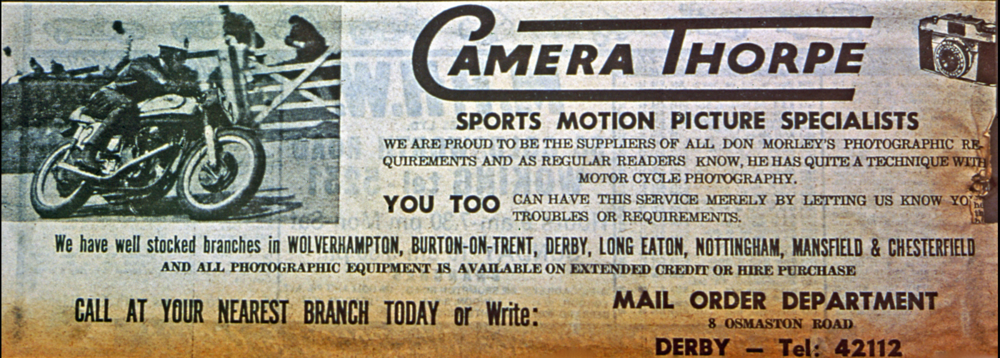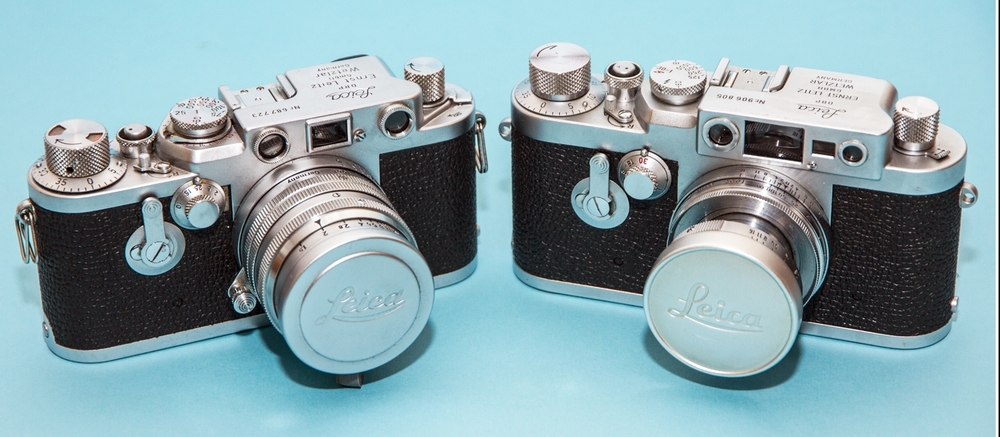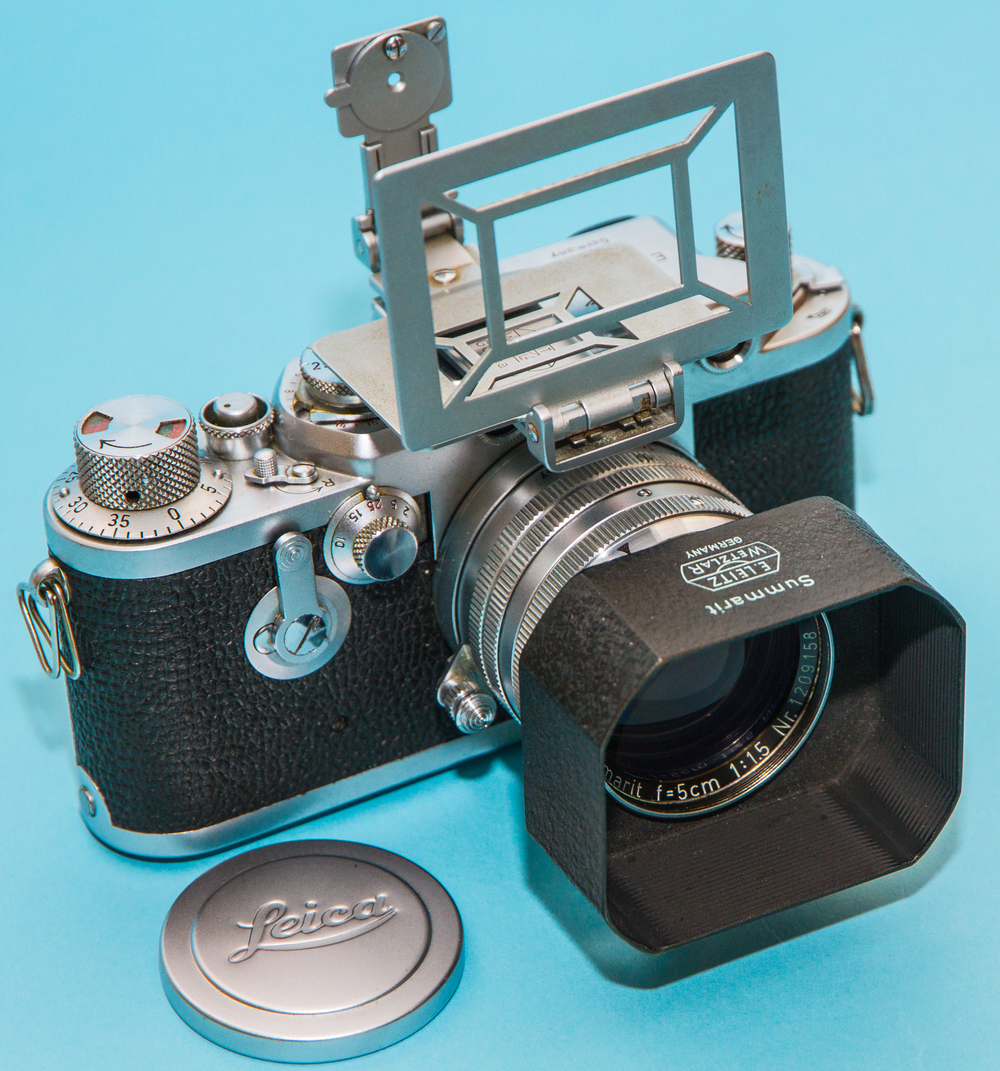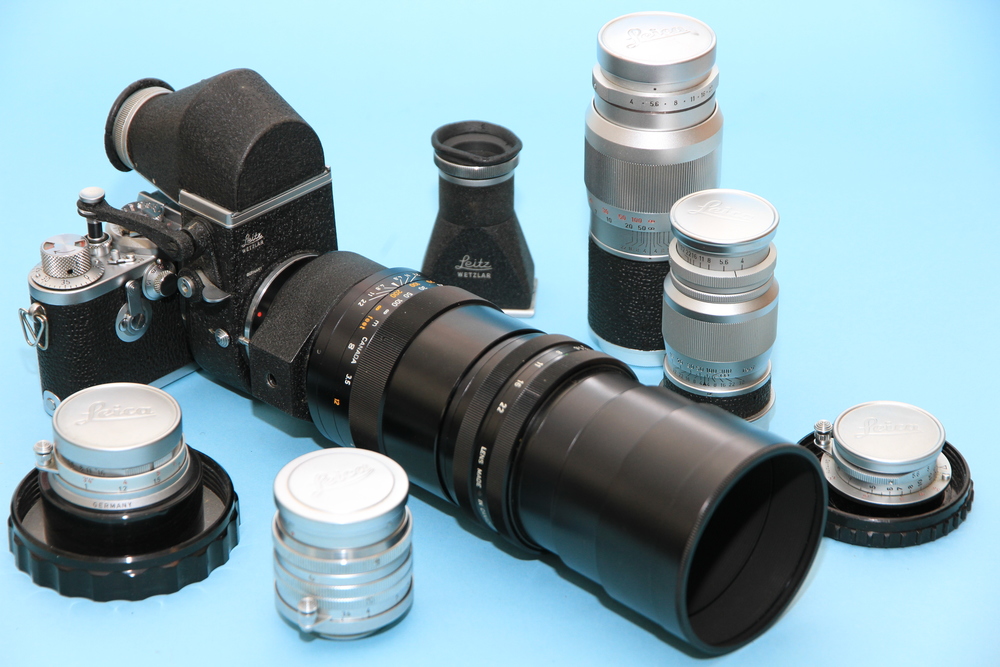
Contrary to popular modern belief, Leica cameras were plentiful back in the 1950s when I first started. Indeed the camera shops had windows full of them BUT they were all pre-war or the spoils of war. As this was a time when Britain had to export or die, the last thing our government wanted anyone to do was import foreign goods, and especially not from any country which until very recently had been a bitter enemy.
It was thus quite impossible for anyone to simply walk into a camera shop and buy a new Leica, even from such as a pre-war Leica specialist or agent. On the other hand, if you were a professional photographer (and could prove you desperately needed such as a new Leica to be able to do your job) you might stand a chance. You could apply to what had been the wartime Ministry of Supply for an import licence, a process which involved navigating your way through masses and masses of red tape.

Fortunately I was working as a professional and felt I could put up a good case for a IIIf because it was flash synchronised whereas the many WWII or pre-war cameras on offer were not. I had to get my import licence application signed by a Justice of the Peace, also my employer or newspaper editor and a doctor or senior policeman. All of this took a very long time with no certainty of success. Nevertheless, that was how I got my wonderful 1954 IIIf.
Bentley disaster
In those days I was about the only person in the UK media shooting colour so I also needed a second body, which (variously) was either a IIIb or IIIc modified for flash synchro, and this all worked fine. But one day in the late ‘50s I was photographing the Gold Cup car races at Oulton Park, Cheshire, and standing on a earth mound right on the edge of the track (no Armco in those days). An eight-litre Bentley spun in from behind me, quite literally demolishing the mound I was standing on and knocked me flying. My camera case with the vital second body and most of my lenses disappeared under half a ton of earth.

Despite the offending vehicle being a late 1920s vintage eight-litre Bentley, this it was not a vintage race. Rather, as happened in those days, it was called the Formula Libre race, and it was won by a young unknown chap who had just come over to the UK from Australia by the name of Jack Brabham!
Destroyed
But what of my precious Leicas which I then had to dig out of the dirt? Well the IIIc and case were destroyed and I was not insured. The lenses were full of earth but just about repairable, although clearly I was not going to be able to shoot colour and black and white again until I managed find and afford the necessary replacements.
The money raising bit itself took quite a while before I took the chance of applying yet again to the Ministry of Supply to be able to buy another IIIf. If I were to get it I would have paid £109 which was a relatively vast sum in those days. Indeed, it is probably now equivalent to around £3,000 in terms of purchasing power. This time round, fortunately or unfortunately, the Ministry was on the ball. I soon received a letter approving my application and asking which photographic dealer I wanted it delivering to.
Black market

I opted for the Ministry to send it to Camera Thorpe in Derby who were my nearest dealers. They then got very exited because they had never had a new Leica before and, this being still in the days of the black market, they offered me half as much again over the new price if I was prepared to go in and and legally take possession but then sign it over to them. I declined. Came the big day when I did go in to collect and I was horrified to find Leica had moved on by then from making the IIIf to the IIIg and that was the surprise package I received.
You might think it strange now but I was gutted. There I was having to pay my life savings for a camera I just did not like. It had grown bigger and was no longer the lithe compact the IIIf and its predecessors had been. And I hardly ever used a 50mm lens (and I still don’t) so the much vaunted bigger viewfinder was a complete waste for me, especially as they had not merged it with the rangefinder into one eyepiece window like in the then-new M3.
This was especially apposite for me because my job was very dangerous and I much preferred to use a framefinder a) because we could see round it as well, and hence spy the odd race car with evil intent and b) because it covered all of our range of lenses and so did not need changing in the heat of the moment when, for instance, we were also trying to screw out a 90mm and screw in a 135mm.

To cut a very long story short, I used the IIIg for six months or so then managed to do a straight swap for a mint IIIf and was happy again. The swapee thought it was Christmas and his birthday all rolled into one but I never regretted it and never looked at another IIIg either until a couple of years back. Then I sort of rediscovered it and came to love it in the collector sense. Indeed, if I had to choose now, I might even take the g over the f, but it is still the IIIf which was THE big milestone for me.
A word on the pictures
Note: Click on the thumbnails to enlarge them
Copyright Notice: All photographs in this article are the copyright of Don Morley and may not be downloaded or reproduced without express permission.

The shot of the single camera at the top of this article is of my 1954 red dial and delayed action IIIf with 1954 50mm f/1.5 Summarit lens fitted with its unique lens hood. On the camera is my circa 1954 Leica ROSUL viewfinder which has frames for 5cm, 9cm, 13.5 cm lenses and was a vital accessory in my day for dangerous sports and better than the bright-line finders because you had to change them for each individual lens length.
This is not the actual camera and lens I used in 1954 (at least not as far as I know). But it is similar. Incidentally, I sometimes use the finder and the Summarit on my M9 and both work very well still for digital, though best to stop the lens down to f/2 or below and then up the contrast a bit in Lightroom or whatever.
IIIf and IIIg

The view of the two cameras together shows the IIIf as above plus my 1957 IIIg and its 50mm f/2 Summicron, a lens I never managed to afford back in the 1950s. In fact, my original new IIIg came with a 50mm f/2.8 Elmar which I still have a soft spot for (I do have a mint M version). So neither cameras are my originals BUT both are same year as the ones I used in the fifties.
Press outfit
The picture of the outfit: This again is my 1954 IIIf with my screw thread lenses, some of which are very rare. So the camera is shown fitted to a screw-thread Leica Visoflex II (OTYDO) which in screw-thread fitting form is quite rare in itself (I have two), and as shown it has the (OTXBO) right-way-round pentaprism, then behind this the picture also shows the upright magnifying finder/viewer.
The lens fitted is a ultra-rare E. Leitz Canada 280mm f/4.8 Telyt which is direct M rather than screw fitting and is quite rare in itself. My particular lens is even rarer still, so much so that very few of even the most esteemed of Leica specialists have ever heard of it, though it does get a few almost throwaway lines in Erwin Put’s book.

Basically, this is from the era when virtually all Leica’s lenses were made by Leica Canada rather than by or at Wetzlar and near the time of the German Leica company’s first big financial collapse. The 280mm Telyt was re-designed by Leitz Canada so it was more suited for use on the ‘R’ models as well as the ‘M’, and even changed the mount so it no longer needed the old OUBIO adapter which on the previous version was needed both to fit and to be able to rotate it.
Anyway, as said, Canada much simplified all of this in addition also to improving it optically, and these versions are also quite rare. What it seems even very few experts know about, they then had another 1980s go at making even more improvements to this lens just about the time the entire Leica company was imploding. [Editor’s note: In a comment to this article, Dr. Andreas Kaufmann says: “the Canadian factory of Ernst Leitz never was closed. It exists until this day under the name of Elcan—Ernst Leitz Canada—and produced the last lenses around 2008 (f1 Noctilux)]

As said, Puts is the only writer I have known to pick up on this, and it does not look as though even he knows very much about the very final few; he just says something like “from lens number ……… this lens was re-designed optically to give better definition and contrast”.
Well, my lens is after that number, and I still have the box and its Passport, etc. It was not sold (by Leica UK) until 13 November 1984, which, if I recall correctly, was quite a long time after the Canadian factory had closed. Obviously I had a much earlier version back in the late 1950s.
Also in the picture are my 50mm Summarit and 50mm Summicron as already mentioned, plus a circa 1954 90mm f/4 Elmar and two other real rarities: My 135mm f/4 Elmar, which is very unusual in screw-thread form, and my even rarer 28mm f/5.6 Summaron of which Leica made only a relative few (fewer, in fact, than 4,000 in screw-thread form) and did not make at all as an M-fit lens.
Don Morley, photographer extraordinary

Dear Stephen
I’ll buy you a pint of the ‘black stuff’ the next time you are in Dublin, and Mike and Don as well, of course.
I like the OCOLOY strategy. I sometimes just do it for one day. Would that be OCOLOD?
Best Wishes
William
Dear Stephen,
I certainly had no wish to chastise my comments were just intended to support Mike as I honestly did not think his comments were intended to be taken as in any way political. As to what sort of equipment anyone uses, espouses about, or just love, well sadly I sometimes go off in tangents or just get carried away much I suspect as anyone else.
What I do always try and keep to my minds forefront however is it is just that. I.E Equipment to help with the general photographic process whereas it is our own eyes which matter the most in terms of our actually getting PICTURES.
Anyway I wish you good luck and much enjoyment in our mutual hobby. Best wishes, Don Morley
Dear Mr. Morley,
I consider myself duly chastised, though in mitigation I would state that this is an emotional time for me, since the upcoming referendum has coincided with the passing of my father, who was a lifelong campaigner against British membership of the EU…
Regarding the appreciation of Leica cameras as well as the writings of Mr. Puts, I am in full accord with you, as I have mentioned before, though I am not a collector, I generally only have one camera at a time, I am fascinated by the interest in these matters as espoused by William Fagan, and now yourself. I have not been reading this blog long enough to see the earlier articles posted here, and I have been noting the gradually and seemingly unstoppable increase in the scale of Michael’s Leica collection, though I am quite determined not to amass a collection myself.
I do not consider myself to be a particularly talented photographer, but I enjoy myself and I have done so throughout my life. During the past year I have been following a sort of ad hoc course as suggested by Michael Johnston of "The Online Photographer", that he calls… OCOLOY (one camera, one lens, one year), I went hard core, and have also more or less kept to one film and one developer… Kodak Tri-x and Rodinal R09. I scan my negatives onto my Mac, using a Nikon CoolScan.
At this point, I am fairly sure that I am not a natural with a camera, or with film, but undeterred I will carry on, but in the future, I am going to return to digital, though in the manner of a film photographer, if that makes any sense… I am not that good at judging the prevailing light, so I need a built in light meter, and I think that in the modern Leicas, the broader tolerances of the sensor enable me to "get away with it" more often than I have been with film.
As with our host, I have been eagerly anticipating the apparently upcoming Leica M-D, and whilst accepting the criticism leveled by Mr. Puts of the digital camera (I understand that the following was written some time ago), I have just re-read the following appreciation of the Leica MP and post the URL as an example of this man’s excellent writing on the subject.
http://www.imx.nl/photo/leica/camera/Leica-camera/page30.html
Again, I am sorry to yourself, William and our host, for being over sensitive and emotional.
Dear Stephen
I am sure there’s no need to be worried. We all have our moments and I am sure your comment was not taken amiss by William, Don or me. As I said before, I am very grateful for your dedication and the frequency of your comments which (as in this one) offer a great deal of insight and sense. I wish I could stick to one camera, one lens, one year but if you think about it I would have nothing to write about!
Keep the comments coming.
Mike
Wow I am quite taken a back by some of the comments and am sure Mike or anyone else never intended to get political, and I must add I greatly enjoyed William Fagan’s input not least because I too lust after several early Leica’s and also covered such as the North West 200 road races over in Ireland on many occasions, not to mention my also covering the Isle Of Man TT as well for 51 years (See my book ‘TT In Camera’), however modern Leica’s are also my thing and they include my wonderful ‘T’ outfit and what I have come to regard as the vastly under rated X-Vario, in addition of course to my M9’s.
Dear Stephen
My comment related solely to eliminating any possibility of a ‘black market’ emerging on the border between Ireland and Northern Ireland. This could be tackled two ways; firstly by Britain staying within the EU and, secondly, by some form of provision in a British exit process which would allow the recognition of the longstanding special relationship between our two countries which would allow neither country to lose and also prevent various nefarious elements (I suspect you know who I am talking about) from entering again onto the scene.
I made no comments about whether Britain or Ireland being in the EU is a good or a bad thing. Politics on MacFilos? Heaven Forbid!
William
Thanks for the clarity William…
I have to say that I am not averse to a "black market" though… Do you recall the beginning of Spike Milligan’s Puckoon, where the bar is split between the north and the south?
What an absolutely wonderful story, Don. Even those of a similar age tend to look back at the screw-thread Leicas and assume that they were not up to the rugged press job such as yours. I find it amazing to see the full press outfit and the IIIf at the top of the article looks stunning. Keep on supplying more stories like this!
Good point, John, I too was intrigued by the pro photographer setup, especially the Leicflex. I wouldn’t mind getting one to try on my own IIIf.
My humble apologies for suggesting the Canadian Leica factory was no more and my sincere thanks to the good Doctor Kaufmann for pointing out the error of my ways, indeed in this instance it was wonderful to be proved wrong and I would also now love to know if the renamed Elcan company still has any connection to the modern company of Leica in Wetzlar?
On re reading my article I was also more than a little concerned my comments about Erwin Puts ‘Only’ knowing about or mentioning the facts about Leitz Canada revamping the very final version of the Canadian 280mm f4 Telyt also came over as sounding a bit flip, which certainly was not my intention.
What I did actually mean was of all the Leica specialist writers whose works I have ever read, and believe me there are many, he remains as being THE only one who picked up on this very rare final 280mm lens version, indeed no wonder I have always rated Erwin the highest, and incidentally I rarely buy anything modern Leica without first consulting whatever Erwin has written about it first. Don Morley
, whereas ed feel I also should apologise
Thanks Don for the wonderful article. The import licence aspect is interesting. One can only hope that if ‘Brexit’ actually happens we will not see a repeat of this. On our side of the Irish Sea we are staying in the EU but even then the prospect of a ‘black market’ opening up again just up the road on the border with Northern Ireland is not enticing. Let is hope that wise counsel prevails in all of this.
My favourite Leicas are from the 1920s to the1940s and I have a reasonably large collection of items from that era. I have most of the 1950s models as well and my favourite camera from that era is the IIf Red Dial with 1,000th top speed. I have the IIIf and the IIIg with the self timer but I prefer to have nothing under my right hand. I like the IIIg but, like you, I have never completely bonded with it. Offered a choice between a IIIg or a II Model D (both ends of ‘built in rangefinder’ evolutionary scale) I would take the II Model D every time. To prove that I already have 4 II Model Ds, 3 black and 1 Chrome
Focus and recompose is my favourite technique and I do like to be able to see around the framed subject. A ROSUL viewfinder has just joined my list of ‘wants’. I have never ventured into Visoflex territory for two reasons. Firstly, I fear that I might ‘get lost’ and might never come back and, secondly, the thing I really like about Leicas is their small size and lack of weight compared to SLRs
I am a motoring racing fan and I recall being taken to the Phoenix Park (a public park) in Dublin by my father to see Formula Libre racing in the late 1950s and early 1960s. They had anything and everything in those races. There was, indeed, much less concern about public safety in those days and people stood at the side of the road watching the cars. The Phoenix Park was used for motor racing up to less than 10 years ago but by that stage additional ‘safety items’ like straw bales and some crash barriers had appeared. I have seen photos from the 1960s which show photographers standing a few feet away (as little as five feet away) from the then current Formula 1 cars going at top speed. Rallying was and is the most difficult in terms of crowd control. The situation really got out of control in the 1980s with the introduction of Group B cars such as the Audi Quattro (I recently posted a picture of one on this site). The solution at the time was to ban the cars which were considered to be too powerful to be let near humans! For the ultimate unsafe (largely to the competitors) motor sport, motorcycle road racing in Northern Ireland in events like the North West 200 take some beating. Michael will recall the Isle of Man TT from the old days. The version in Northern Ireland is like that except it is also ‘wheel to wheel’ and in much less space.
Thanks Don for all of the interesting themes you have brought up in your wonderful piece; from import licenses to sports photography to Leica use and collecting and safety in motor sport. You have made my day!
William
Beware! Politics alert. Sorry Mike, I know that you don’t like politics here! But I could not leave this, I had to respond.
William, I am not sure what you mean by "wise counsel prevailing", but I would just say that I prefer freedom from oppression and a return of sovereignty… i.e. What your country (and my wife’s) fought for, through those long years of British rule.
I trust that "wise counsel prevailing" means an orderly break-up of the EU, beginning with a British exit, rather than the highly unpredictable alternative.
There are far more nation states now than there were immediately following WW2, they must be doing something right. Supranationalism is a bankers wet dream.
I offer Greece as an example of this oppression.
Stephen.
Please note that the Canadian factory of Ernst Leitz never was closed. It exists until this day under the name of Elcan (Ernst Leitz Canada) and produced the last lenses around 2008 (f1 Noctilux)
Dr. Kaufmann, I am grateful for your pointing this out and I should have picked it up when editing Don’s article. I will add a correction in the article at the first opportunity.
Andreas, I was the head of the optical design group at Elcan and it was my team that worked on Noctilux (pre-asphere) to produce the first version that did not use the famous (but very expensive) Leitz custom glass formulas. I hand carried the prototype to Wetzlar where it was declared "it’s good!" after MTF testing. Thanks for sharing the great yarn about the Bentley demolition job! Most entertaining.